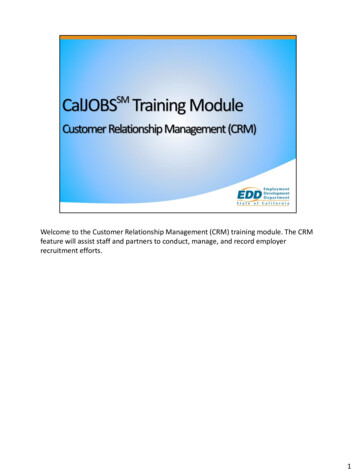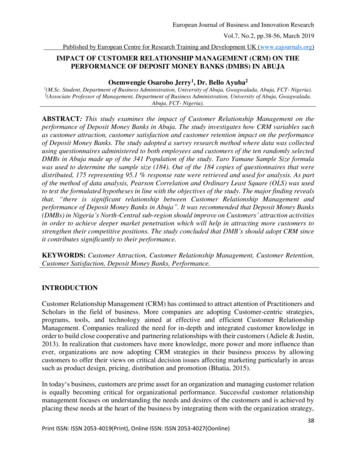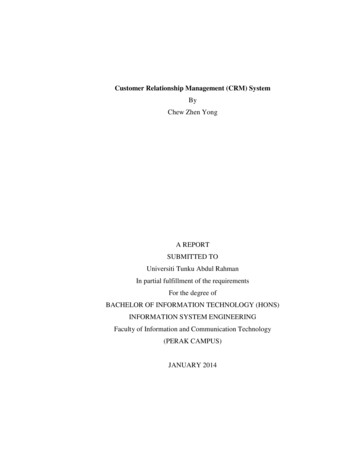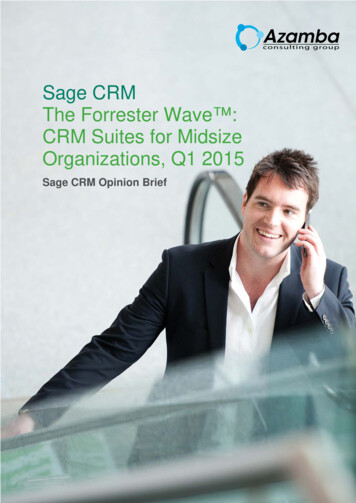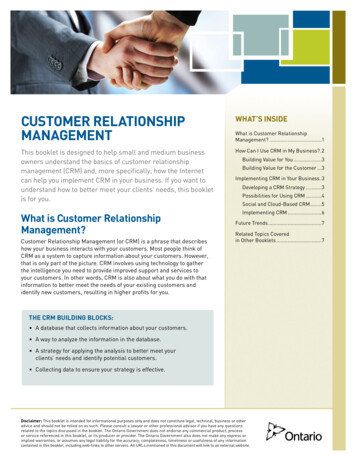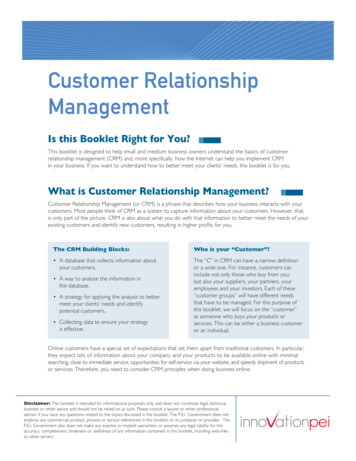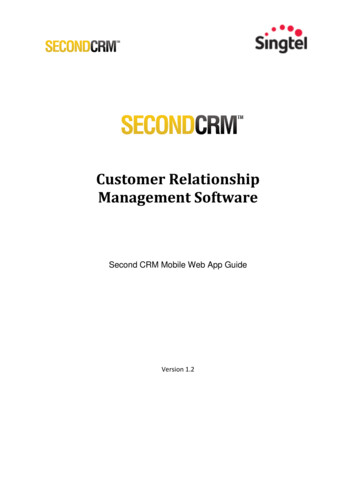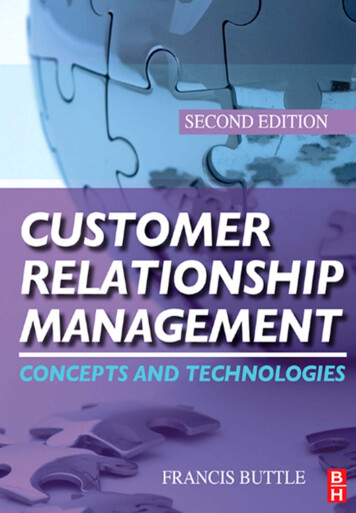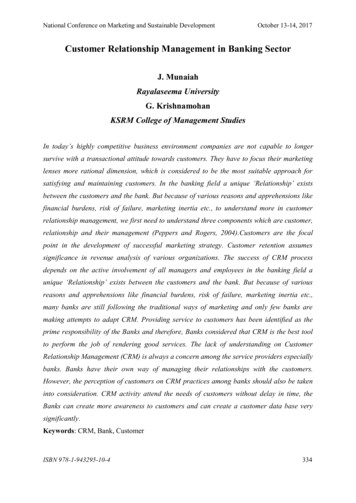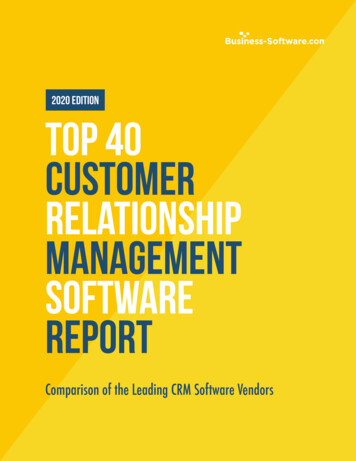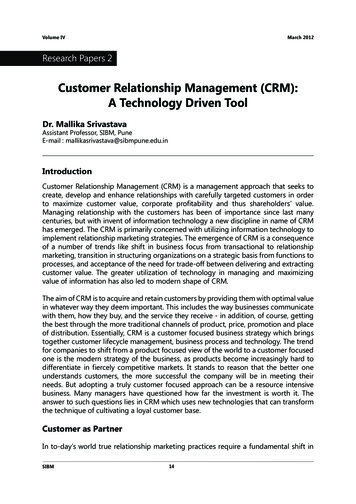
Transcription
Volume IVMarch 2012Research Papers 2Customer Relationship Management (CRM):A Technology Driven ToolDr. Mallika SrivastavaAssistant Professor, SIBM, PuneE-mail : mer Relationship Management (CRM) is a management approach that seeks tocreate, develop and enhance relationships with carefully targeted customers in orderto maximize customer value, corporate profitability and thus shareholders’ value.Managing relationship with the customers has been of importance since last manycenturies, but with invent of information technology a new discipline in name of CRMhas emerged. The CRM is primarily concerned with utilizing information technology toimplement relationship marketing strategies. The emergence of CRM is a consequenceof a number of trends like shift in business focus from transactional to relationshipmarketing, transition in structuring organizations on a strategic basis from functions toprocesses, and acceptance of the need for trade-off between delivering and extractingcustomer value. The greater utilization of technology in managing and maximizingvalue of information has also led to modern shape of CRM.The aim of CRM is to acquire and retain customers by providing them with optimal valuein whatever way they deem important. This includes the way businesses communicatewith them, how they buy, and the service they receive - in addition, of course, gettingthe best through the more traditional channels of product, price, promotion and placeof distribution. Essentially, CRM is a customer focused business strategy which bringstogether customer lifecycle management, business process and technology. The trendfor companies to shift from a product focused view of the world to a customer focusedone is the modern strategy of the business, as products become increasingly hard todifferentiate in fiercely competitive markets. It stands to reason that the better oneunderstands customers, the more successful the company will be in meeting theirneeds. But adopting a truly customer focused approach can be a resource intensivebusiness. Many managers have questioned how far the investment is worth it. Theanswer to such questions lies in CRM which uses new technologies that can transformthe technique of cultivating a loyal customer base.Customer as PartnerIn to-day’s world true relationship marketing practices require a fundamental shift inSIBM14
Volume IVMarch 2012attitude towards viewing the customer as a partner and a business asset to be managedfor long-term profitability. The sale should not be viewed either as a conquest or asthe end of the marketing process; rather it should be constructed as the beginning ofa relationship. The information technology, which includes the telecommunications,data storage and retrieval technologies, and the World Wide Web, have created arevolution that has shifted the business firm’s orientation from production efficiencyback to the customers’ needs. IT could draw the customer closer to the company, builda relationship, and reduce the probability of customer defection.With technology touching the way we live our lives, expectations of individuals is fastchanging. Just like television and the PC’s have revolutionized our lives so is wirelesscommunications, Internet and pervasive computing going to affect our daily pattern oflives. Some trends that have bearing on treating customers as partners can be seen as: More and more individuals will like to be treated as one single person ratherthan as one among the masses. People wish products and services round the clock With abundance of product and service offerings, consumer’s loyalty can onlybe commanded by providing better portfolio of services. Speed of response and understanding each individual one of the major keyissuesImportance of Technology in Customer RelationshipIT is enabler and choosing right technology is managerial acumen. First one has tofind out initiatives which need improvements through technology, Identifying theseinitiative is one of the key tasks of a manager. In the context of CRM, initiatives whichneed improvement and applicability of IT are shown in Exhibit 1.Exhibit 1: Importance of Technology to initiativeSIBMInitiatives to improveImportance of Requirements of customerIT to initiative relationship-management systemTargeting of profitable customersvery highIntroduce propensity modeling-for example,rule-based systems to improve capture ofmost important customer variablesAbility to deal with follow-up contactsHighCreate campaign library with history of offersmade to targeted customers; make availableon-line to call-center agentsConvenience of responseHighEnable response through convenient channelssuch as e-mail or, for mobile-phone users,Short Message Service (SMS)Delivery of offerHighAutomate delivery of successive messages tocustomers who have not yet respondedPresentation of offer(sales pitch, material)LowIntroduce sales scripts for call-center agents;employ support systems that help customizescripts by customer segmentAttractiveness of offerNoneN/A15
Volume IVMarch 2012Success of CRM is dependent upon the choosing the activity that involves datahandling, complex modelling and requires lesser subjectivity/human intervention.Technological ToolsThe application of technology is the most exciting, fastest growing, and changing theway customers get information about products and services. Technology includes allof the equipment, software, and communication links that organizations use to enableor improve their processes, including everything from simple overhead transparencyprojectors to laptop computers, from fax machines to email, from audiocassette andvideocassette players to cellular phones and voice mail(Stowell,1997)1.The most widelyused tools are :1) Electronic Point of Sale (EPOS) : The main benefit of EPOS and retail scannersystems is the amount of timely and accurate information they deliver. Advancesin the technology have significantly aided the scope for data analysis. IN additionto the original scanner-related data on sales rate, stock levels, stock turn, price andmargin, retailers now have information about the demographics, socio-economicand lifestyle characteristics of consumers. They can, in addition, assess the impactof a whole host of variables-price, promotion, advertising, position in store, shelfposition, number of facings, and so on. This information drives their choice ofproduct mix, allocation of shelf space and promotional tactics. EPOS has certainlychanged the relationship between buyer and seller (Shipley and Palmer, 1997)2.2) Sales Force Automation : These systems help in automating and optimizingsales processes to shorten the sales cycle and increase sales productivity. Theyenable the company to track and manage all qualified leads, contacts, andopportunities throughout the sales cycle including customer support. They improvethe effectiveness of marketing communications programs for generating qualityleads as well as greater accuracy in sales forecasting. The Internet can be usedby the company in imparting proper training to its sales force. In-depth productinformation, specialized databases solutions, sales force support queries, and a setof internal information on the Internet can improve the productivity of the salesforce.3) Customer Service Helpdesk :These applications help the company in automatingthe customer support processes, which enable it to deliver high quality service totheir customers. Such software helps in logging the information about customers,enquiries, and suggestions, etc. It also helps in directing these queries to appropriateemployees within the company. It maintains information regarding status ofcustomer enquiries and stores all support calls and related communications tofinal resolution, continually updating the database accordingly. With an automatedcustomer service, a company can reduce the costs of maintaining its customer servicedepartment while at the same time improving the level and quality of customerservice. Customer service using the web provides more information and tools in theSIBM16
Volume IVMarch 2012hands of customers, which enhances customer benefits by allowing them to learnmore about the product and improving their skills in using the product.4) Call Centers : Call centre helps in automating the operations of inbound andoutbound calls generated between company and its customers. These solutionsintegrate the voice switch of automated telephone systems with agent host softwareallowing for automatic call routing to agents, auto display of relevant customer data,predictive dialling, self-service interactive Voice Response systems, etc. These systemsare useful in high volume segments like banking, telecom and hospitality. Today,more innovative channels of interacting with customers are emerging as a resultof new technology, such as global telephone based call centres and the Internet.Companies are now focusing to offer solutions that leverage the Internet in buildingcomprehensive CRM systems allowing them to handle customer interactions in allforms.Systems IntegrationWhile CRM solutions are front office automation solutions, ERP is back office automationsolution. An ERP helps in automating business functions of production, finance,inventory, order fulfillment and human resource giving an integrated view of business,whereas CRM automates the relationship with a customer covering contact andopportunity management, marketing and product knowledge, sales force management,sales forecasting, customer order processing and fulfillment, delivery, installation, presale and post –sale services and complaint handling by providing an integrated viewof the customer It is necessary that the two systems integrate with each other andcompliment information as well as business workflow. Therefore, CRM and ERP arecomplementary. This integration of CRM with ERP helps companies to provide fastercustomer service through an enabled network, which can direct all customer queries,and issues through appropriate channels to the right place for speedy resolution. Thisfacilitates the company in tracking and correcting the product problems reported bycustomers by feeding this information into the R&D operation via ERP.CRM Process FrameworkTechnological advancements in the recent times have enabled business organizationsto automate their processes. This has resulted in greater profits through cost reductionin costs cycle time and workforce. CRM technologies enable an organization to presenta single point of contact to its customers. CRM is a broad term encompassing manystrategies, processes and technologies all working in tandem to get as close to thecustomer as possible. In order to have healthy relationship with its customers thecompany needs to monitor its customer’s behaviors in each transaction and providethem what they want.The Meta Group uses the CRM architectural framework to analyze where thedifferent solutions fit in from holistic perspective. CRM process framework has threeSIBM17
Volume IVMarch 2012primary components operational or process Management technologies, analyticalor performance management technologies required to achieve a balanced CRMapproach.”(Source: SAS white paper)3 and collaborative.1) Operational : CRM solutions involve integration of business processes involvingcustomer touch points. These technologies reside in those parts of a company wheremoments of truth occur i.e. a customer makes direct contact with the employees ofthe company. Typical CRM solutions that fit into this category are customer sales andservice, sales force automation, marketing automation and field services. The backoffice side of the operational CRM solutions should be able to plug into ERP systemsand chain management software.2) Analytical : CRM analysis the data created on the operational side of the CRM effortfor the purpose of business performance management and improvement. Predictionof customer behavior, identifying relevant customer segments, identifying potentialcustomers etc are some of the activities that could be performed from the knowledgearising out of analytic CRM efforts.3) Collaborative : CRM involves the facilitation of collaborative services (such as email)to facilitate interactions between customers and employees. All this effort producesrich data that feeds the Analytical CRM technologies. It analyses the data using datamining and other technologies and in turn feeds the result (i.e. knowledge gained)back to the operational and collaborative CRM technologiesExhibit 2: Interactions with CRM TechnologiesOperational CRMAnalytical CRMCollaborative CRMCustomerCustomer Relationship Management is a technology initiative that aims to strengthenthe front-end operations and build a mutually valuable long-term relationship with thecustomers. A firm might enjoy competitive advantage of its customers for a long timeby building mutually beneficial relationships that increase switching costs and thuscannot be easily replicated. Studies have also shown that it costs as much as five timesto acquire a new customer than to retain one. All customers do not contribute equallyto a firm’s profitability-some positively while others contribute negatively to the firm’sbottom line. It is the endeavor of a firm to nurture these profitable customers. CRMintegrates all front-end operations of the firm so that a customer is presented with asingle point of contact that remembers all as the past customer interactions.A typical CRM cycle consists of front-end operations that interact with the customerSIBM18
Volume IVMarch 2012(like call centers, target marketing initiatives etc.) and obtain data about customer. Thisis typically consolidated from various contact points and fed into a data warehouse.The data warehouse consolidates not only transaction data but also data obtainedfrom outside sources like census data and provides a fertile ground for an
Customer Relationship Management (CRM): A Technology Driven Tool. Dr. Mallika Srivastava. Assistant Professor, SIBM, Pune. E-mail : mallikasrivastava@sibmpune.edu.in. Introduction. Customer Relationship Management (CRM) is a management approach that seeks to create, develop and enhance relationships with carefully targeted customers in orderFile Size: 344KBPage Count: 12
